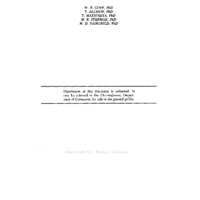-
Title
-
Effects of 1, 1-Dimethylhydrazine (UDMH) on Evoked Cerebral Neuroelectric Responses
-
Date
-
1967
-
Index Abstract
-
Not Available
-
Photo Quality
-
Complete
-
Report Number
-
AMRL TR 67-67
-
Creator
-
Goff, W. R.
-
Allison, T.
-
Matsumiya, Y.
-
Corporate Author
-
Yale University School of Medicine
-
Laboratory
-
Aerospace Medical Research Laboratories
-
Extent
-
16
-
Identifier
-
AD0663764
-
Access Rights
-
Distribution of this document is unlimited. It may be released to the Clearinghouse, Department of Commerce, for sale to the general public.
-
Distribution Classification
-
1
-
Contract
-
AF 33(615)-2822
-
DoD Project
-
6302
-
DoD Task
-
630202
-
DTIC Record Exists
-
Yes
-
Distribution Change Authority Correspondence
-
None
-
Abstract
-
The neural mechanisms of UDMH intoxication were studied by analyzing changes in cortical, subcortical, and cerebellar neuroelectric potentials evoked by peripheral nerve stimulation. Results showed that the negative component of the primary somatosensory cortical evoked potential was markedly potentiated by UDMH intoxication while the positive component of this response together with the response from the specific somatic sensory thalamic relay and from the cerebellum were unaffected. The potentiation almost always occurred in the absence of other evoked or spontaneous neuroelectric changes and preceded epileptiform seizure by several minutes. Thus it was usually the sole predictor of seizure. Motor paralysis markedly prolonged seizure onset. These results indicate the UDMH intoxication increases intracortical excitability acting primarily at axo-dendritic synapses to block inhibitory post-synaptic potentials. The resulting positive sensory-motor feedback is an important element in the production of seizures.
-
Report Availability
-
Full text available
-
Date Issued
-
1967-09
-
Provenance
-
RAF Centre of Aviation Medicine
-
Type
-
report
-
Format
-
1 online resource
 AMRLTR67-067.pdf
AMRLTR67-067.pdf